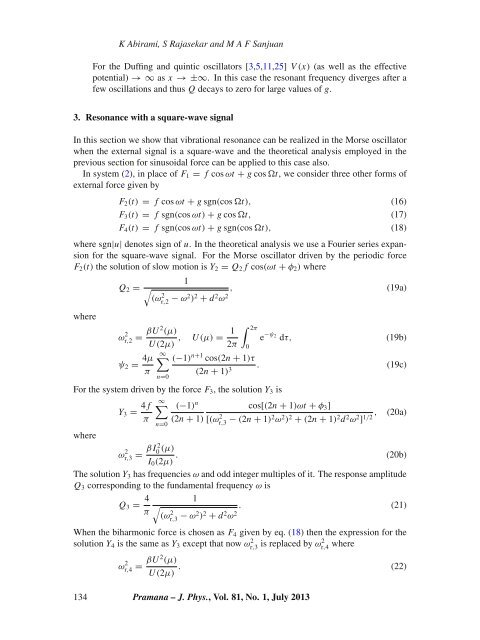Vibrational resonance in the Morse oscillator - Indian Academy of ...
Vibrational resonance in the Morse oscillator - Indian Academy of ...
Vibrational resonance in the Morse oscillator - Indian Academy of ...
You also want an ePaper? Increase the reach of your titles
YUMPU automatically turns print PDFs into web optimized ePapers that Google loves.
K Abirami, S Rajasekar and M A F Sanjuan<br />
For <strong>the</strong> Duff<strong>in</strong>g and qu<strong>in</strong>tic <strong>oscillator</strong>s [3,5,11,25] V (x) (as well as <strong>the</strong> effective<br />
potential) →∞as x →±∞. In this case <strong>the</strong> resonant frequency diverges after a<br />
few oscillations and thus Q decays to zero for large values <strong>of</strong> g.<br />
3. Resonance with a square-wave signal<br />
In this section we show that vibrational <strong>resonance</strong> can be realized <strong>in</strong> <strong>the</strong> <strong>Morse</strong> <strong>oscillator</strong><br />
when <strong>the</strong> external signal is a square-wave and <strong>the</strong> <strong>the</strong>oretical analysis employed <strong>in</strong> <strong>the</strong><br />
previous section for s<strong>in</strong>usoidal force can be applied to this case also.<br />
In system (2), <strong>in</strong> place <strong>of</strong> F 1 = f cos ωt + g cos t, we consider three o<strong>the</strong>r forms <strong>of</strong><br />
external force given by<br />
F 2 (t) = f cos ωt + g sgn(cos t), (16)<br />
F 3 (t) = f sgn(cos ωt) + g cos t, (17)<br />
F 4 (t) = f sgn(cos ωt) + g sgn(cos t), (18)<br />
where sgn|u| denotes sign <strong>of</strong> u. In <strong>the</strong> <strong>the</strong>oretical analysis we use a Fourier series expansion<br />
for <strong>the</strong> square-wave signal. For <strong>the</strong> <strong>Morse</strong> <strong>oscillator</strong> driven by <strong>the</strong> periodic force<br />
F 2 (t) <strong>the</strong> solution <strong>of</strong> slow motion is Y 2 = Q 2 f cos(ωt + φ 2 ) where<br />
Q 2 =<br />
1<br />
√(ω 2 r,2 − ω2 ) 2 + d 2 ω 2 , (19a)<br />
where<br />
∫ 2π<br />
ωr,2 2 = βU 2 (μ)<br />
U(2μ) , U(μ) = 1<br />
2π 0<br />
e −ψ 2<br />
dτ,<br />
(19b)<br />
ψ 2 = 4μ ∞∑ (−1) n+1 cos(2n + 1)τ<br />
.<br />
π (2n + 1) 3 n=0<br />
(19c)<br />
For <strong>the</strong> system driven by <strong>the</strong> force F 3 , <strong>the</strong> solution Y 3 is<br />
Y 3 = 4 f ∞∑ (−1) n<br />
cos[(2n + 1)ωt + φ 3 ]<br />
π (2n + 1) [(ω 2 n=0<br />
r,3 − (2n + 1)2 ω 2 ) 2 + (2n + 1) 2 d 2 ω 2 ] , 1/2 (20a)<br />
where<br />
ωr,3 2 = β I 0 2(μ)<br />
I 0 (2μ) .<br />
(20b)<br />
The solution Y 3 has frequencies ω and odd <strong>in</strong>teger multiples <strong>of</strong> it. The response amplitude<br />
Q 3 correspond<strong>in</strong>g to <strong>the</strong> fundamental frequency ω is<br />
Q 3 = 4 1<br />
.<br />
π<br />
√(ωr,3 2 − ω2 ) 2 + d 2 ω 2 (21)<br />
When <strong>the</strong> biharmonic force is chosen as F 4 given by eq. (18) <strong>the</strong>n <strong>the</strong> expression for <strong>the</strong><br />
solution Y 4 is <strong>the</strong> same as Y 3 except that now ωr,3 2 is replaced by ω2 r,4 where<br />
ωr,4 2 = βU 2 (μ)<br />
U(2μ) . (22)<br />
134 Pramana – J. Phys., Vol. 81, No. 1, July 2013
















